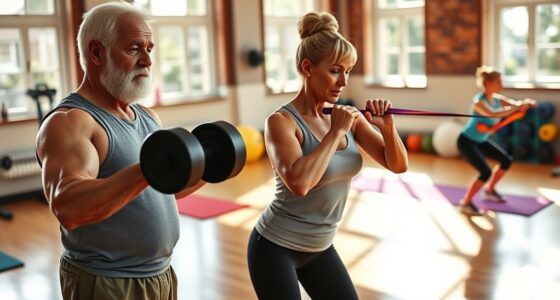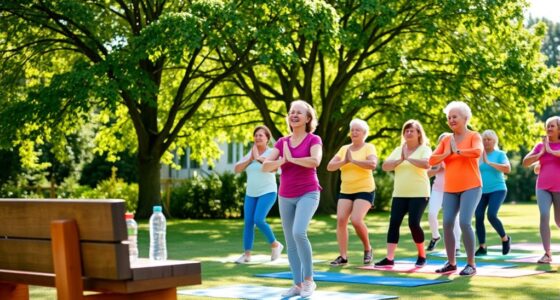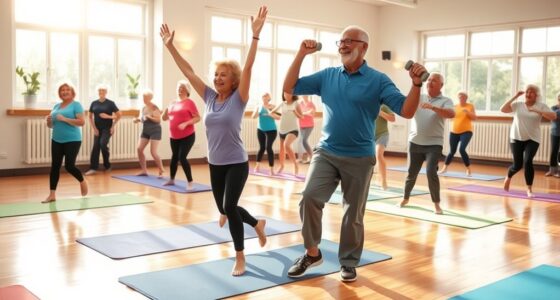Water walking is a fantastic low-impact exercise for seniors, helping you stay fit and flexible while reducing stress on your joints. It improves balance and cardiovascular health, making it ideal for your overall wellness. Start by walking in waist-high water, swinging your arms for stability, and gradually increase your pace. You can enhance flexibility with leg lifts and torso twists. Discover more tips and techniques to make the most of your water walking experience!
Key Takeaways
- Water walking is a low-impact exercise that minimizes joint stress, making it ideal for seniors with mobility concerns.
- Start in waist-high water and gradually increase speed while swinging your arms to enhance balance and stability.
- Incorporate variations like high knees and side walking to boost intensity and improve flexibility.
- Use foam weights or resistance bands during your sessions to strengthen upper body muscles effectively.
- Combine water walking with other activities such as aqua aerobics for a comprehensive fitness routine.
Benefits of Water Walking for Seniors
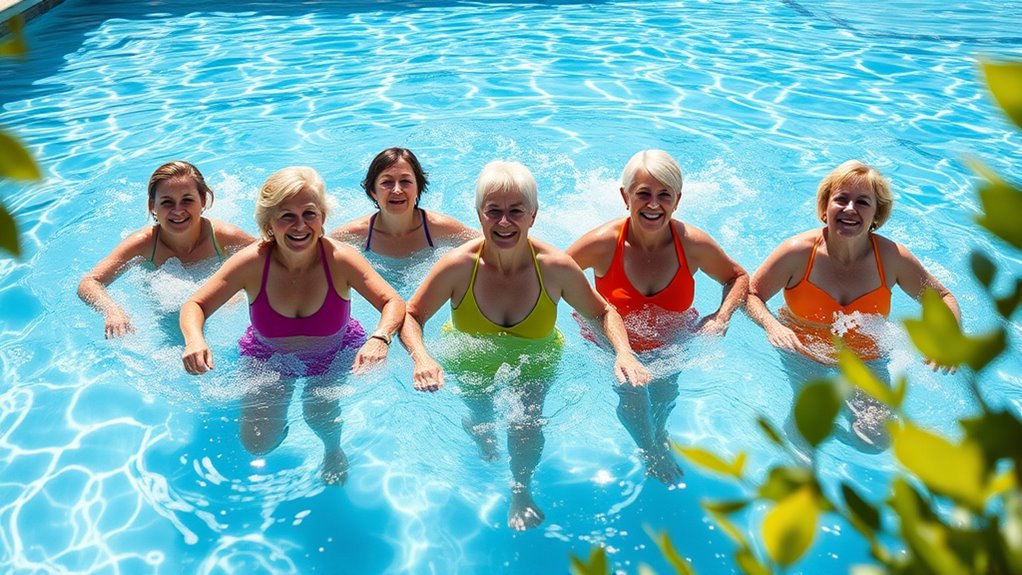
When you engage in water walking, you’re not just enjoying a pleasant activity; you’re also reaping numerous benefits that can greatly enhance your quality of life as a senior.
This low-impact exercise reduces joint stress, making it ideal for those with arthritis or osteoporosis. You’ll improve your balance, lowering your risk of falls, while strengthening your leg and core muscles through water resistance. Additionally, improved balance contributes to overall stability, which is vital for preventing accidents. Furthermore, enhancing life at home can create a supportive environment that encourages regular physical activity. Engaging in outdoor activities like water walking can also provide a refreshing change of scenery, fostering a more positive outlook on life. Moreover, participating in regular exercise, such as water walking, can be an effective way to manage emotional processing during challenging times. Studies have shown that routine health checks can help identify issues early, leading to better overall health outcomes. Research on exercise has demonstrated its role in enhancing mental well-being for seniors.
Water walking boosts cardiovascular fitness, enhancing your heart health and circulation. It also improves flexibility and range of motion, essential for maintaining mobility.
For those dealing with chronic pain or conditions like fibromyalgia, water walking offers relief, making it a smart choice for a healthier, more active lifestyle.
How to Perform Water Walking Effectively
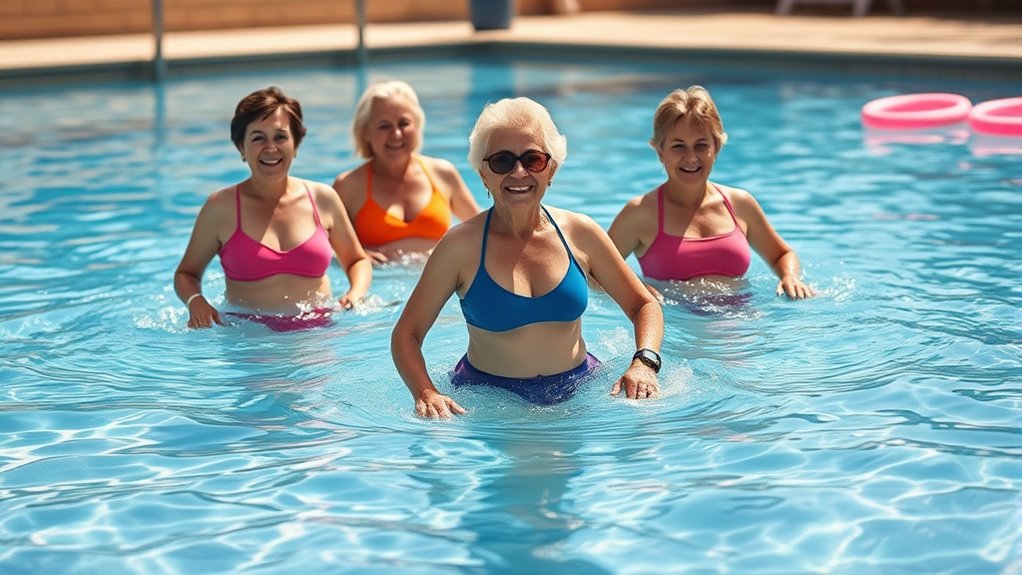
Water walking isn’t only beneficial but also straightforward to perform effectively.
Start in waist-high water for comfort and support, maintaining a straight back while engaging your core. Swing your arms like you’d on land to enhance stability. Regularly checking your form can help prevent injuries during exercise. Achieving proper posture during your workout can further enhance your overall effectiveness and reduce strain. Engaging in water walking can also improve muscle strength, as the water provides resistance. Additionally, incorporating exercises like Turkey Bean and Tomato Zoodle Bowl into your diet can support your fitness goals. Air purifiers are also essential for maintaining a healthy environment, especially if you exercise indoors.
For foot placement, press into your heels first, then roll onto your toes for a smooth stride. Begin slowly and gradually increase your speed to challenge your muscles. Engaging in water walking provides low-impact exercise that is gentle on the joints.
To intensify your workout, try high knees, walk sideways, or alternate between walking and jogging. Consider adding resistance tools, like water shoes, for more challenge.
Don’t forget to stay hydrated and verify your pool’s conditions are safe. Enjoy your water walking sessions and feel the benefits!
Enhancing Flexibility Through Water Walking
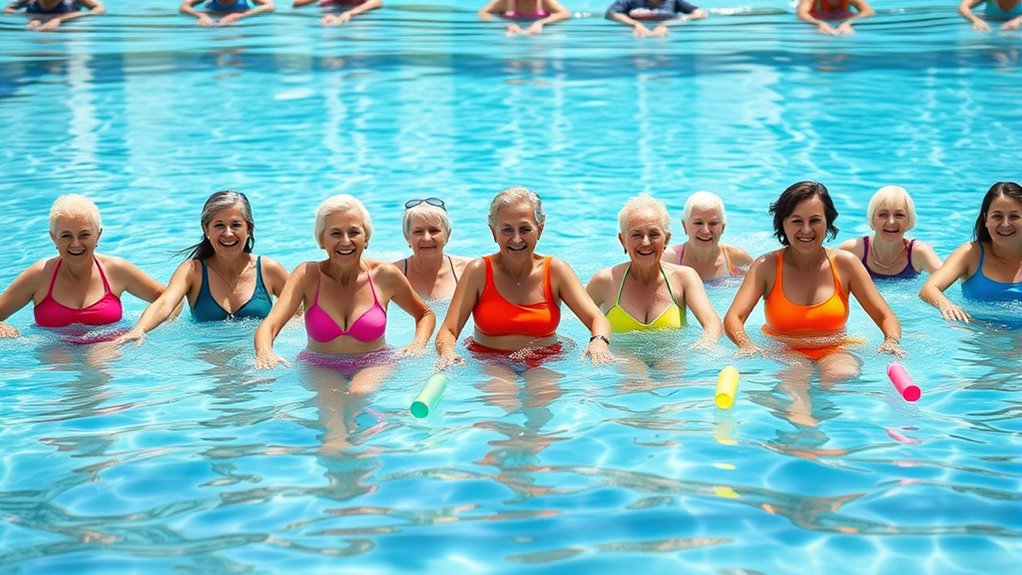
Although you mightn’t think of water walking as a flexibility booster, this gentle exercise can markedly enhance your range of motion. The buoyancy of water supports your joints, allowing you to move freely without the stress that land-based exercises can impose. Engaging in water-based activities can also improve your overall budget for physical fitness by providing a cost-effective way to stay active. Incorporating gentle stretching before and after your water walking can further enhance your flexibility and mobility.
As you walk, you’ll notice improved mobility and increased flexibility in your legs and hips. Incorporating movements like leg lifts and torso twists in the water further enhances your flexibility and balance, which is vital for fall prevention. Additionally, the water’s buoyancy significantly reduces stress on your joints, making it an ideal exercise for those with arthritis or osteoporosis. Engaging in regular water walking not only promotes flexibility but also contributes to better overall health and well-being, as it helps maintain muscle tone while being easy on your joints. Furthermore, pet therapy can also aid in managing behavioral issues for seniors by providing a calming and enjoyable activity. Engaging in regular water walking not only promotes flexibility but also contributes to better overall health and well-being.
Safety Precautions for Seniors While Water Walking
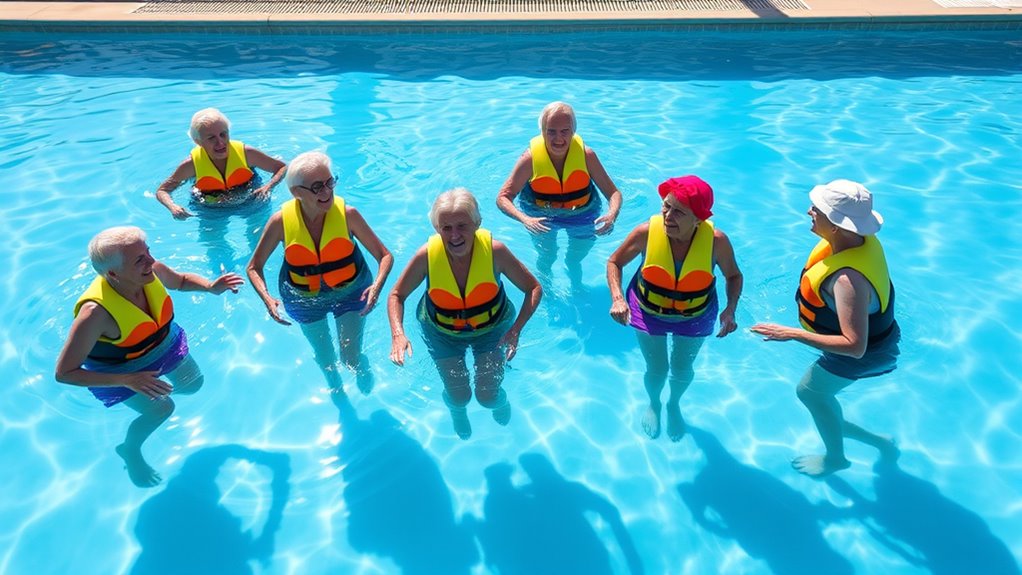
Ensuring safety while water walking is essential for seniors, as it helps prevent accidents and promotes a more enjoyable experience.
First, consult your doctor before starting, especially if you have any health conditions. Wear proper footwear, like water shoes, to prevent slips around the pool. Always choose a clear and safe environment for your activities. Engaging in gentle exercises can improve your overall strength and stability, and incorporating multi-functional gear can enhance your workout experience. Portable AC units can help maintain a comfortable temperature if you’re exercising outdoors near a pool. Additionally, practicing astrological compatibility might boost your confidence while participating in group activities. Regular hydration is crucial for seniors to maintain their energy levels during physical activities and can promote overall skin health.
It’s best to walk with a companion and have flotation devices handy for extra support. Water aerobics can also be beneficial as it provides gentle resistance that helps improve balance. Monitor the water temperature and avoid extreme weather conditions. Be cautious of wet surfaces, and use handrails when entering or exiting the pool.
Stay hydrated, apply sunscreen, and never engage in water activities alone. These precautions will help you enjoy your water walking safely.
Health Benefits of Regular Water Walking
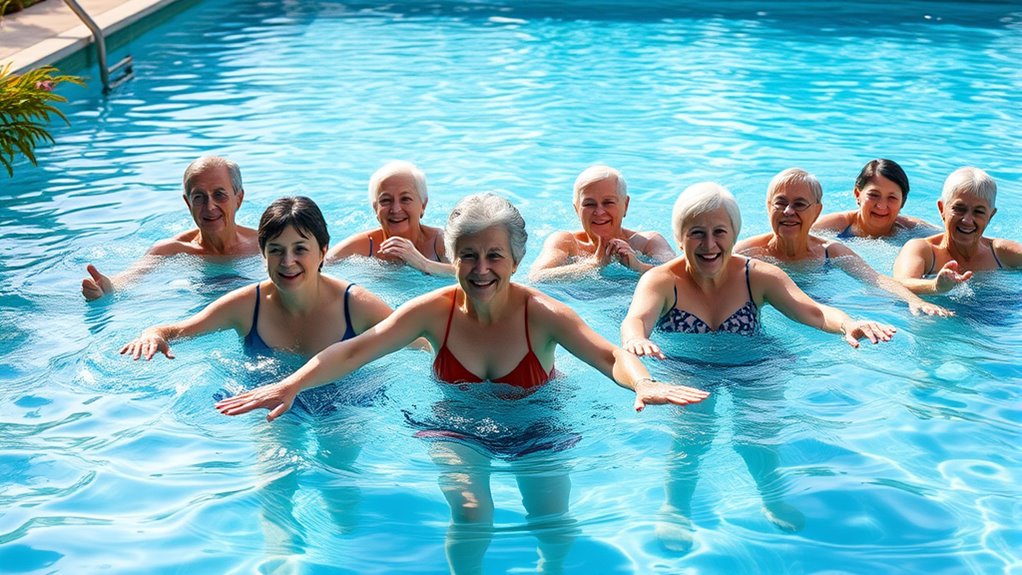
After taking the necessary safety precautions, you can fully embrace the numerous health benefits that regular water walking offers.
This low-impact exercise reduces stress on your joints, making it ideal if you have arthritis or other joint issues. The water’s buoyancy enhances balance, lowering your risk of falls. Additionally, hydrostatic pressure helps reduce joint pain and improves circulation, further supporting your overall well-being. Regular exercise, like water walking, can also lead to improved respiratory health, which is beneficial for seniors. Engaging in regular physical activity can also help alleviate feelings of isolation, similar to seniors texting humor as a way to connect with others. Furthermore, consistent physical activity can lead to energy savings in daily life, allowing for more active engagement in social and recreational activities. Moreover, it fosters collaboration and teamwork through group activities, enhancing social interaction among participants. Incorporating predictive modeling into fitness plans can help identify personal goals and track progress effectively.
You’ll also strengthen your muscles and improve flexibility while enjoying a full-body workout. Water walking elevates your heart rate, boosting cardiovascular health and increasing circulation.
Plus, it helps manage chronic conditions like joint pain and high blood pressure. With its supportive environment, you’ll experience pain relief and enhanced mobility.
Ultimately, water walking not only benefits your physical health but also promotes social engagement and mental well-being.
Integrating Water Walking Into Your Daily Routine
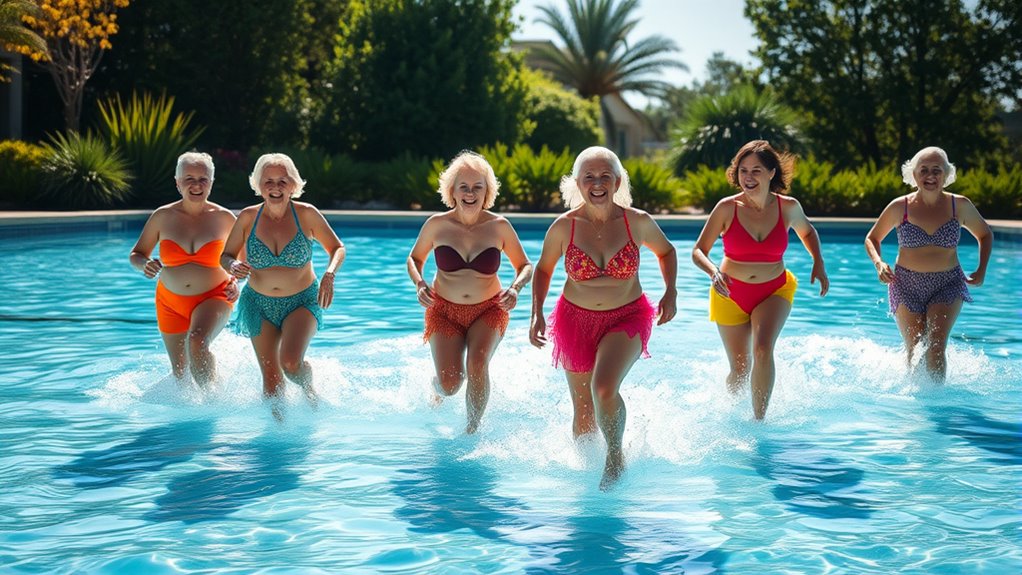
Integrating water walking into your daily routine can be an invigorating way to stay active and healthy. Start by scheduling at least three sessions a week to build consistency. You can combine water walking with other activities like yoga for a thorough workout. Aim for cooler parts of the day to avoid overheating, and begin with shorter sessions, gradually increasing the duration as your comfort and endurance improve. Engaging in water walking also enhances flexibility and balance, which is essential for reducing fall risks. Additionally, staying hydrated is crucial for maintaining optimal physical performance during your workouts. Remember that incorporating mindfulness practices can further enhance your focus and enjoyment during these sessions. Choose a comfortable pool environment with easy entry points, and consider participating in group sessions for motivation. Furthermore, incorporating creative solutions can lead to discovering new ways to enhance your water walking experience. Don’t forget to wear water shoes for better traction and stability. Using scratching posts can also help keep your environment pleasant and motivate you to stay committed to your own fitness journey. With these steps, you’ll find water walking becomes a rewarding and enjoyable part of your routine. Dogs, like Border Collies, require regular physical activity, which can inspire you to stay committed to your own fitness journey.
Increasing Intensity and Difficulty in Water Walking
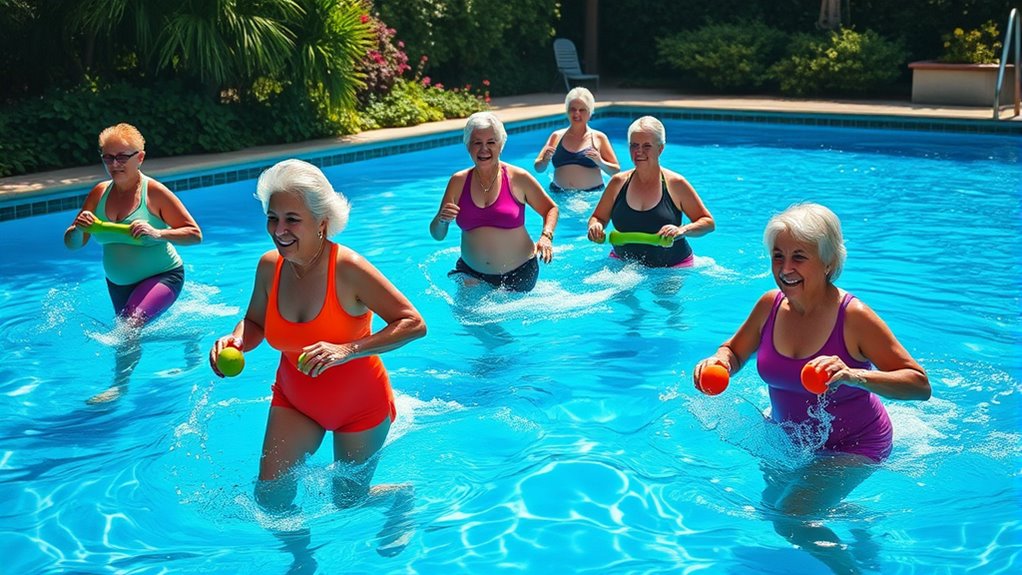
As you become more comfortable with water walking, you can easily increase the intensity and difficulty of your workouts to continue challenging your body.
Start by gradually increasing your session duration and speed as your endurance improves. Try high knee variations to engage your leg muscles further. Incorporate arm movements with foam weights or resistance bands to enhance your upper body workout. Shifting to deeper water will boost resistance, challenging your core stability. Additionally, these modifications will not only improve overall health but also keep your workouts fresh and help you achieve better results in strength, endurance, and overall fitness. Engaging in visualization techniques can further enhance your motivation and performance during these water exercises. Including protein-rich options in your post-workout nutrition can help with muscle recovery and growth. You can also add interval training, alternating between high and low intensity to maximize cardiovascular benefits. Furthermore, strategic planning regarding your financial health, such as understanding tax implications on retirement accounts, can provide peace of mind as you focus on your fitness journey.
Combining Water Walking With Other Water Exercises
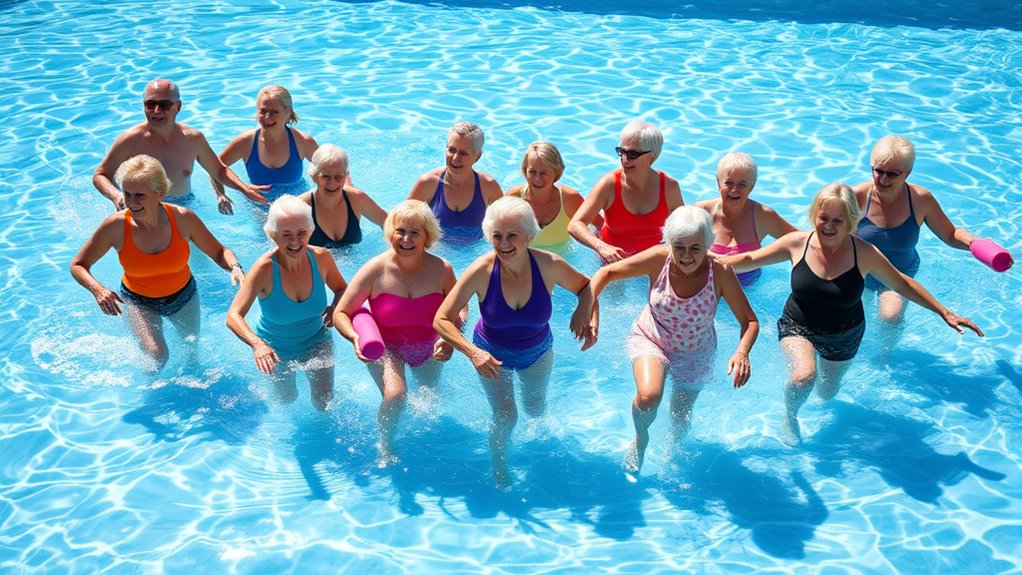
Increasing the intensity of your water walking workouts can lead to great results, but combining this activity with other water exercises can elevate your fitness routine even further.
By integrating aqua aerobics or pool jogging, you’ll boost your cardiovascular health while enjoying reduced joint stress. Adding leg lifts or arm curls enhances muscle strength, while incorporating aqua yoga promotes flexibility and relaxation. Additionally, regular exercise increases your overall stamina and energy levels, contributing to better daily activity performance.
To improve balance and coordination, consider exercises that focus on stability. Using water-based equipment like hand paddles or ankle weights can further challenge your muscles.
Plus, engaging in varied exercises provides mental health benefits, helping you feel accomplished and reducing stress. So, mix it up for a more effective and enjoyable workout!
Frequently Asked Questions
What Type of Water Shoes Are Best for Water Walking?
When you’re looking for the best water shoes for water walking, focus on comfort and support.
Choose shoes with a multi-port drainage system to keep your feet dry, and make certain they’ve a non-slip sole for traction on wet surfaces.
Look for lightweight materials like mesh that breathe well, and consider options with arch support to enhance comfort.
Brands like Columbia or Ryka offer reliable choices tailored to your needs.
How Often Should Seniors Practice Water Walking Each Week?
You might think that exercising just once a week is enough, but if you want to see real benefits, consistency is key.
For seniors, practicing water walking 2-3 times a week is ideal. Each session should last about 30-45 minutes. This regularity helps improve your cardiovascular fitness and strengthens your muscles over time.
Don’t forget to include a warm-up and cool-down to maximize your routine and keep your body safe!
Can Water Walking Help With Arthritis Symptoms?
Yes, water walking can greatly help with arthritis symptoms.
You’ll find that the buoyancy of water reduces stress on your joints, making it easier and less painful to move. The warm water relaxes your muscles, providing pain relief and enhancing your mobility.
Plus, the resistance of water helps strengthen your muscles without high-impact stress. Regularly incorporating this exercise into your routine can improve your overall quality of life and reduce stiffness.
What Is the Ideal Water Depth for Water Walking?
The ideal water depth for water walking is waist-deep, as it provides enough support to reduce joint stress while allowing for a natural walking motion.
At this depth, you engage your leg muscles effectively without overwhelming impact on your joints.
If you’re a beginner, starting in hip-deep water can also be beneficial, offering easier entry and support while still providing resistance.
Always remember to wear water shoes for better stability and grip!
Are There Any Contraindications for Seniors With Specific Health Issues?
“You can’t make an omelet without breaking a few eggs.”
When considering exercise for seniors, it’s essential to recognize contraindications. If you have contagious diseases, serious epilepsy, or urinary tract infections, you should avoid certain activities.
Always consult your doctor about any specific health issues you may have. Remember, safety first!
Monitoring your health and knowing your limits guarantees you stay active while minimizing risks associated with exercise.
Conclusion
Incorporating water walking into your routine is like adding a revitalizing splash of energy to your day. As you glide through the water, you’ll not only boost your strength and flexibility but also nurture your spirit. Embrace the gentle resistance of the waves, allowing each step to rejuvenate your body and mind. So, plunge in and make water walking a delightful part of your journey toward a healthier, more active life—where every stride brings you closer to wellness.


